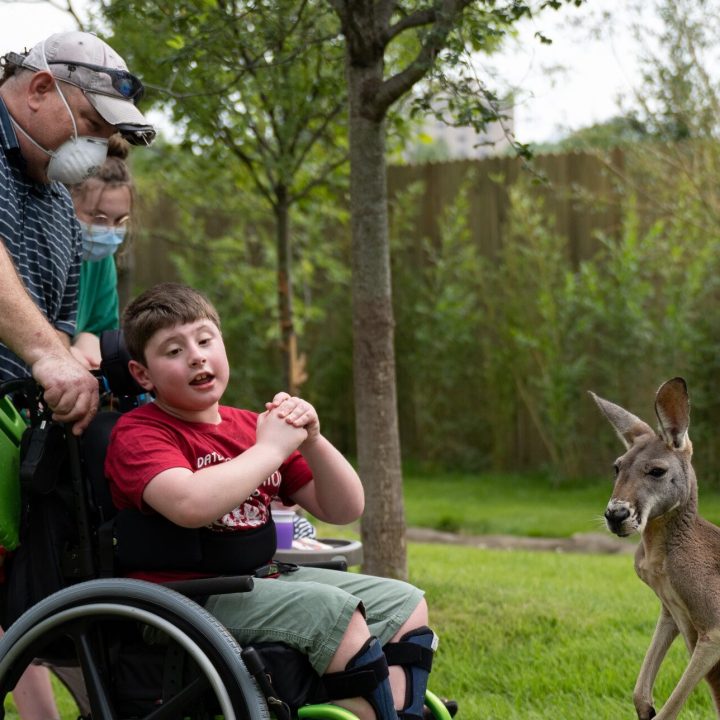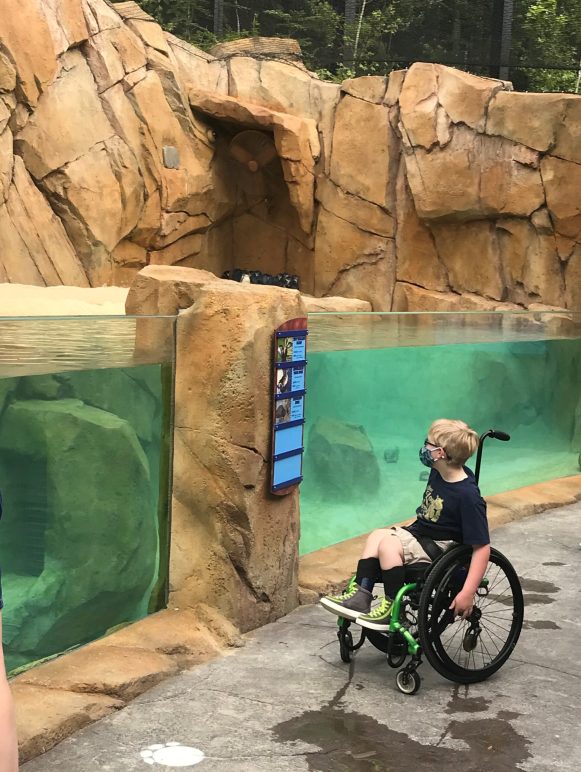
Cassandra Clement was always on the lookout. A self-described “stalker” of quiet places to sit at the Cincinnati Zoo & Botanical Garden (CZBG), she always took note of benches tucked away in more secluded areas, or any nook or cove that would make a “good place to chill” with her son Troy, who has a genetic disorder called Angelman syndrome. For the Clements, like many families with developmental disabilities, the zoo was both a place of refuge from the daily challenges of living with a disability and a source of anxiety. Visitors with sensory sensitivities can be overwhelmed by the sounds and smells of a zoo, and others may struggle to understand social expectations in public places.
In support of the zoo’s mission to “inspire every visitor with wildlife every day,” CZBG embarked on an initiative in 2017 to become more accessible and inclusive, for individuals with developmental disabilities, low socioeconomic status, English as a second language, and terminal illnesses that prevent them from visiting the zoo. The initiative, Zoo Access for All, was supported by a four-year “Community Anchors” grant from the Institute of Museums & Library Services (IMLS) for the work with developmental disabilities, which this article focuses on.
As the grant cycle reaches the end of year three, Rhiannon Hoeweler, the program’s founder and the zoo’s Vice President of Visitor Experience, Strategy & FUN!, reflects on what made the project a community success.
“We offer on-site resources like sensory bags, social narratives, and a calming room,” Hoeweler says. “But the most impactful components to this program are the connections we made from the beginning with local Cincinnati Children’s Hospital Medical Center’s (CCHMC) LEND Program, and the creation of a Family Advisory Council to guide the work.” These trusting relationships between the CZBG and its community partners were the key to developing a program responsive to the specific needs of the Cincinnati community.
Only two city blocks from CZBG sits one of the leading children’s hospitals in the country, whose Leadership Education in Neurodevelopmental and Related Disabilities (LEND) program trains professionals to support the disability community in Cincinnati. Since the beginning of the Zoo Access for All program, LEND’s Program Director, Dr. Jen Smith, has collaborated with CZBG to train zoo employees and identify priority areas to increase accessibility.
Over four hundred CZBG employees have gone through the unique training with Dr. Smith, learning some of the types of developmental disabilities they may encounter at the zoo, how they can support those with developmental disabilities, and how they can assist families when issues arise. One of the main purposes of the training is to make interacting with families with developmental disabilities less intimidating. Employees can be role models and advocates, and the training helps them feel better prepared to make every visitor’s experience at CZBG magical.
As a local expert on the subject, Dr. Smith’s involvement in the program helps families trust in the changes being made. Dr. Smith has been working with many other cultural institutions across the greater Cincinnati region, providing education and resources to places like the Newport Aquarium, Cincinnati Art Museum, the Cincinnati Reds, and even the Cincinnati/Northern Kentucky International Airport. Together, these organizations along with many others have created the Greater Cincinnati Access and Inclusion Network, to share ideas, resources, and collaborate to create a more inclusive region.
Dr. Smith says, “When these organizations partner together, there’s less heavy lifting to create a program from scratch. They can learn what’s working at other organizations and ask questions and having similar resources at similar organizations helps our families know what to expect. There’s also great local pride in saying to a visitor, ‘If you liked the resources at the zoo, you’ll love the events at the museum this weekend!’”
As valuable as medical expertise is, no one knows the challenges of a zoo visit for the neurodiverse better than our member families with developmental disabilities, so Dr. Smith and CZBG invited twenty families representing different disabilities, age groups, and socioeconomic statuses to serve as part of the Zoo’s Access for All Family Advisory Council. These families committed to serving as advisory members of the council for the length of the grant, sharing their experiences, guiding the direction of the program, and advocating for the work in the community. Their perspectives were vital to understanding how the zoo can create the best experiences for them.
“Unless you’ve been through it yourself, you never realize the challenges faced by the special needs community,” says Leesha Thrower, an FAC member whose daughter was born with Down syndrome. “You want your children to be included in all parts of life and have those outside the community understand how to interact and be supportive.”
The members of the FAC, who also included Cassandra and Troy Clement, helped set the goals and dreams for the program, which were not always what the CZBG team expected. Some of the improvements the zoo has made on the FAC’s recommendation include, for instance, installing four adult-size changing tables, creating a sensory-friendly Santa meet-and-greet during the holiday season, and constructing calming rooms for when a family needs a place to self-regulate from sensory overload. The FAC also serve as major advocates for the zoo with other families with disabilities, as they communicate about these improvements and the successful visits they’ve allowed for.
The FAC also helps in planning new habitats opening at the zoo, providing vital expertise to help staff account for pinch points. For instance, When the zoo opened a new habitat called Roo Valley this August, the FAC families were invited to a private event to experience the new habitats and provide feedback. Events like this help CZBG better train employees, prep and distribute social narratives, and make updates to signage when needed.
“They’re making fantastic changes,” Cassandra Clement says. “How cool for them to be the leaders in Cincinnati for true accessibility. And it has been fun to be a part of the improvements.”

While the CZBG team will submit the final reports for the IMLS grant in 2021, the program is built to last. Now being chaired by Alix Gasser, Director of Membership, Business Development and FUN!, and Dave Jenike, Chief Operating Officer and Vice President, the Zoo Access for All program will continue to grow and evolve. “We want to stay relevant within our community in an ever-changing world,” Gasser says. “I think our Zoo Access for All program will continue to do just that”.
Now, the CZBG is exploring other ways to become more accessible to visitors with disabilities, like those who are blind or visually impaired. The work is not done; it’s only the beginning. “This program is ingrained in the culture of the Zoo now,” says Dave Jenike.
For more information on the Zoo Access for All program, visit www.cincinnatizoo.org/plan-your-visit/zoo-access-for-all.







